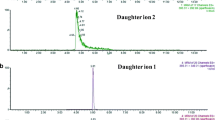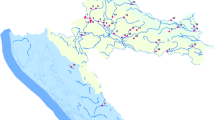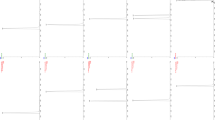Abstract
A liquid chromatography–electrospray tandem mass spectrometry (LC–MS/MS) method for the determination of antibiotics in water was developed and applied to Brazilian surface waters. Amoxicillin, ampicillin, cefalexin (CEF), ciprofloxacin (CIP), norfloxacin (NOR), sulfamethoxazole, tetracycline (TET), and trimethoprim were selected as target compounds due to their high consumption pattern in Brazil. LC and MS conditions were optimized to produce the maximum analytic response for each compound. Anion exchange and polymeric solid-phase extraction cartridges, in series, were employed during the extraction procedures. Recovery, linear range, limit of detection (LOD), and limit of quantification were calculated. LOD varied from 0.13 ng L−1 for CIP and NOR to 0.76 ng L−1 for TET. Surface water samples from the Atibaia watershed (São Paulo State, Brazil) were analyzed. Results showed that seasonal and anthropogenic aspects dictated the levels of antibiotics in the samples. An overall frequency of detection of 55% was observed during the rainy period, whereas a higher percentage (88%) was noticed for samples collected during the dry season. In the Atibaia River, sample concentrations ranged from 29 ng L−1 for CEF to 0.5 ng L−1 for NOR. In a sewage-affected stream, however, concentrations up to 2422 ng L−1 CEF were found.



Similar content being viewed by others
References
Abraham WR, Macedo AJ, Gomes LH, Tavares FCA (2007) Occurrence and resistance of pathogenic bacteria along the Tietê River downstream of São Paulo in Brazil. Clean Soil Air Water 35:339–347
Al-Ahmad A, Daschner FD, Kümmerer (1999) Biodegradability of cefotiam, ciprofloxacin, meropenem, penicillin G, and sulfamethoxazole and inhibition of wastewater bacteria. Arch Environ Contam Toxicol 37:158–163
Alexy R, Sommer A, Lange FT, Kümmerer K (2006) Local use of antibiotics and their input and fate in a small sewage treatment plant―Significance of balancing and analysis on a local scale vs. nationwide scale. Acta Hydrochim Hydrobiol 34:587–592
ANVISA (2006) National Health Surveillance Agency, National assembly for the regulation of the drug market. Available at: http://www.anvisa.gov.br/monitora/cmed/index.htm.
Barbarin N, Henion JD, Wu Y (2002) Comparison between liquid chromatography–UV detection and liquid chromatography–mass spectrometry for the characterization of impurities and/or degradants present in trimethoprim tablets. J Chromatogr A 970:141–154
Benito-Peña E, Partal-Rodera AI, León-González ME, Moreno-Bondi MC (2006) Evaluation of mixed mode solid phase extraction cartridges for the preconcentration of beta-lactam antibiotics in wastewater using liquid chromatography with UV-DAD detection. Anal Chim Acta 556:415–422
Blackwell PA, Kay P, Boxall ABA (2007) The dissipation and transport of veterinary antibiotics in a sandy loam soil. Chemosphere 67:292–299
Botitsi E, Frosyni C, Tsipi D (2007) Determination of pharmaceuticals from different therapeutic classes in wastewaters by liquid chromatography–electrospray ionization–tandem mass spectrometry. Anal Bioanal Chem 387:1317–1327
Brundtland GH (1999) Global partnerships for health. WHO Drug Inform 13:61–62
Chico J, Rubies A, Centrich F, Companyó R, Prat MD, Granados M (2008) High-throughput multiclass method for antibiotic residue analysis by liquid chromatography–tandem mass spectrometry. J Chromatogr A 1213:189–199
Choi K, Kim Y, Jung J, Kim MH, Kim CS, Kim NH et al (2008) Occurrences and ecological risks of roxithromycin, trimethoprim, and chloramphenicol in the Han River, Korea. Environ Toxicol Chem 27:711–719
Choi KJ, Kim SG, Kim CW, Kim SH (2007) Determination of antibiotic compounds in water by on-line SPE-LC/MSD. Chemosphere 66:977–984
Da Silva GS, Jardim WF (2007) Application of ammonia total maximum daily load (TMDL) to Atibaia River, Campinas/Paulínia region–São Paulo state. Eng Sanit Ambient 12:160–168
Davey P, Ferech M, Ansari F, Muller A, Goossens H (2008) Outpatient antibiotic use in the four administrations of the UK: cross-sectional and longitudinal analysis. J Antimicrob Chemother 62:1441–1447
Feitosa-Felizzola J, Chiron S (2009) Occurrence and distribution of selected antibiotics in a small Mediterranean stream (Arc River, Southern France). J Hydrol 364:50–57
Focazio MJ, Kolpin DW, Barnes KK, Furlong ET, Meyer MT, Zaugg SD et al (2008) A national reconnaissance for pharmaceuticals and other organic wastewater contaminants in the United States. II. Untreated drinking water sources. Sci Total Environ 402:201–216
Gartiser S, Urich E, Alexy R, Kümmerer K (2007) Ultimate biodegradation and elimination of antibiotics in inherent tests. Chemosphere 67:604–613
Ghauch A, Tuqan A, Assi HA (2009) Antibiotic removal from water: elimination of amoxicillin and ampicillin by microscale and nanoscale iron particles. Environ Pollut 157:1626–1635
Golet EM, Alder AC, Giger W (2002) Environmental exposure and risk assessment of fluoroquinolone antibacterial agents in wastewater and river water of the Glatt Valley Watershed, Switzerland. Environ Sci Technol 36:3645–3651
Goossens H, Ferech M, Coenen S, Stephens P (2007) Comparison of outpatient systemic antibacterial use in 2004 in the United States and 27 European countries. Clin Infect Dis 44:1091–1095
Hermo MP, Barrón D, Barbosa J (2006) Development of analytical methods for multiresidue determination of quinolones in pig muscle samples by liquid chromatography with ultraviolet detection, liquid chromatography–mass spectrometry and liquid chromatography–tandem mass spectrometry. J Chromatogr A 1104:132–139
Hirsch R, Ternes T, Haberer K, Kratz KL (1999) Occurrence of antibiotics in the aquatic environment. Sci Total Environ 225:109–118
IBGE (2002) National survey on basic sanitation: 2000. Brazilian Institute of Geography and Statistics, Rio de Janeiro, Brazil
Karthikeyan KG, Meyer MT (2006) Occurrence of antibiotics in wastewater treatment facilities in Wisconsin, USA. Sci Total Environ 361:196–207
Kasprzyk-Hordern B, Dinsdale RM, Guwy AJ (2008) Multiresidue methods for the analysis of pharmaceuticals, personal care products and illicit drugs in surface water and wastewater by solid-phase extraction and ultra performance liquid chromatography–electrospray tandem mass spectrometry. Anal Bioanal Chem 391:1293–1308
Kemper N (2008) Veterinary antibiotics in the aquatic and terrestrial environment. Ecol Indic 8:1–13
Kolpin DW, Furlong ET, Meyer MT, Thurman EM, Zaugg SD, Barber LB et al (2002) Pharmaceuticals, hormones, other organic wastewater contaminants in U.S. streams, 1999–2000: a national reconnaissance. Environ Sci Technol 36:1202–1211
Kümmerer K (2009) Antibiotics in the aquatic environment: a review. Part I. Chemosphere 75:417–434
Lam MW, Mabury SA (2005) Photodegradation of the pharmaceuticals atorvastatin, carbamazepine, levofloxacin, and sulfamethoxazole in natural waters. Aquat Sci 67:177–188
Lindberg RH, Wennberg P, Johansson MI, Tysklind M, Andersson BAV (2005) Screening of human antibiotic substances and determination of weekly mass flows in five sewage treatment plants in Sweden. Environ Sci Technol 39:3421–3429
Lindsey ME, Meyer M, Thurman EM (2001) Analysis of trace levels of sulfonamide and tetracycline antimicrobials in groundwater and surface water using solid-phase extraction and liquid chromatography/mass spectrometry. Anal Chem 73:4640–4646
Locatelli MAF (2006) Investigation on emissions and characterization of polycyclic aromatic hydrocarbons (PAHs) in the Atibaia River basin. Master’s degree thesis, University of Campinas
Managaki S, Murata A, Takada H, Tuyen BC, Chiem NH (2007) Distribution of macrolides, sulfonamides, and trimethoprim in tropical waters: ubiquitous occurrence of veterinary antibiotics in the Mekong Delta. Environ Sci Technol 41:8004–8010
Martins AF, Vasconcelos TG, Henriques DM, Frank CS, König A, Kümmerer K (2008) Concentration of ciprofloxacin in Brazilian hospital effluent and preliminary risk assessment: a case study. Clean Soil Air Water 36:264–269
McArdell CS, Molnar E, Suter MJF, Giger W (2003) Occurrence and fate of macrolide antibiotics in wastewater treatment plants and in the Glatt Valley watershed, Switzerland. Environ Sci Technol 37:5479–5486
Pereira FSVT, Bucaretchi F, Stephan C, Cordeiro R (2007) Self-medication in children and adolescents. J Pediatr 83:453–458
Rao RN, Venkateswarlu N, Narsimha R (2008) Determination of antibiotics in aquatic environment by solid-phase extraction followed by liquid chromatography–electrospray ionization mass spectrometry. J Chromatogr A 1187:151–164
Renew JE, Huang C-H (2004) Simultaneous determination of fluoroquinolone, sulfonamide, and trimethoprim antibiotics in wastewater using tandem solid phase extraction and liquid chromatography–electrospray mass spectrometry. J Chromatogr A 1042:113–121
Sodré FF, Locatelli MAF, Jardim WF (2010a) Occurrence of emerging contaminants in Brazilian drinking waters: a sewage-to-tap issue. Water Air Soil Pollut 206:57–67
Sodré FF, Locatelli MAF, Jardim WF (2010b) An in-line clean system for the solid-phase extraction of emerging contaminants in natural waters. Quim Nova 33:216–219
Sodré FF, Montagner CC, Locatelli MAF, Jardim WF (2007) Ocorrência de interferentes endócrinos e produtos farmacêuticos em águas superficiais da região de Campinas (SP, Brasil). J Braz Soc Ecotoxicol 2:187–196
Tamtam F, Mercier F, Le Bot B, Eurin J, Dinh QT, Clément M et al (2008) Occurrence and fate of antibiotics in the Seine River in various hydrological conditions. Sci Total Environ 393:84–95
Urraca JL, Moreno-Bondi MC, Hall AJ, Sellergren B (2007) Direct extraction of penicillin G and derivatives from aqueous samples using a stoichiometrically imprinted polymer. Anal Chem 79:695–701
Volpato DE, De Souza BV, Rosa LGD, Melo LH, Daudt CAS, Deboni L (2005) Use of antibiotics without medical prescription. Braz J Infect Dis 9:288–291
Wang P, Qi M, Sun Y, Yang J (2004) A liquid chromatographic method for simultaneous determination of amoxicillin sodium and sulbactam sodium in a combination formulation. J Pharm Biomed Anal 36:565–569
Watkinson AJ, Murby EJ, Costanzo SD (2007) Removal of antibiotics in conventional and advanced wastewater treatment: Implications for environmental discharge and wastewater recycling. Water Res 41:4164–4176
WHO (2002) Antimicrobial resistance. Factsheet no.194. World Health Organization, Geneva, Switzerland
WHOCC (2009) Anatomical therapeutic chemical (ATC) classification system: guidelines for ATC classification and DDD assignment. World Health Organization Collaborating Centre for Drug Statistics Methodology, Geneva, Switzerland
Wiegel S, Aulinger A, Brockmeyer R, Harms H, Löffler J, Reincke H et al (2004) Pharmaceuticals in the river Elbe and its tributaries. Chemosphere 57:107–126
Xiao Y, Chang JA, Hu J (2008) Trace analysis of quinolone and fluoroquinolone antibiotics from wastewaters by liquid chromatography–electrospray tandem mass spectrometry. J Chromatogr A 1214:100–108
Acknowledgements
The authors thank the State of São Paulo Research Foundation (FAPESP, Projects 2007/52078-2 and 2007/58449-2) and the Brazilian National Counsel of Scientific and Technological Development for financial support. We also thank Carol Collins for revising the manuscript.
Author information
Authors and Affiliations
Corresponding author
Rights and permissions
About this article
Cite this article
Locatelli, M.A.F., Sodré, F.F. & Jardim, W.F. Determination of Antibiotics in Brazilian Surface Waters Using Liquid Chromatography–Electrospray Tandem Mass Spectrometry. Arch Environ Contam Toxicol 60, 385–393 (2011). https://doi.org/10.1007/s00244-010-9550-1
Received:
Accepted:
Published:
Issue Date:
DOI: https://doi.org/10.1007/s00244-010-9550-1




